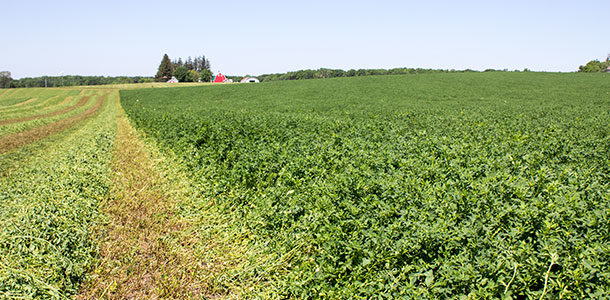He recommends doing a soil test two or more years before planting alfalfa. If the pH is lower than 6, lime should be applied at least a year before planting.
Soil testing should also be done for P and K. (Consult your local university extension office for recommended levels.) Fields that test in the optimum range would then be fertilized based on P and K crop removal. Fields testing lower would be fertilized at a higher rate, and those testing higher would not need fertilizer until those levels drop back to the optimum range.
Six to 12 months before planting, producers should be comparing variety trials and planning weed control, Lang says. He recommended looking at university and industry trials, taking into consideration intended years of rotation, winter survival rating and disease resistance. Other traits to consider may include potato leafhopper resistance, multi-leaf, hybrid alfalfa and low-lignin varieties.
Producers should keep in mind the rotation restrictions to alfalfa of herbicides used on the previous corn or soybean crops. When converting Conservation Reserve Program lands or pasture to alfalfa, plan on applying an herbicide to those perennials in September. If planting in late summer following winter wheat or spring oats, Lang advises to be aware of a flush of voluntary small grains following the alfalfa seeding.
Lang says it doesn’t matter if a producer is planting via broadcast or drill, conventional or no-till; the four most important things to remember for success are seed-to-soil contact, proper seed depth, seeding rate and uniform seed distribution.
He stresses the importance of soil preparation. “You want to make sure to seed alfalfa into a firm seed bed,” he says. “If you sink in deeper than the sole of your shoe when walking on the field, then you should cultipack before planting. You don’t want a fluffy seedbed.”
The planting operation should include press wheels or a final cultipacker pass to assure seed-to-soil contact.
Seed depth should be in the one-quarter to one-half inch range. This can be achieved with the cultipacker pass or with press wheels on a drill. If using an older grain drill, be careful that the small seed tubes are not too close to the small grain disk opener, causing alfalfa seed to be buried too deeply.
Uniform seed distribution is usually not a problem unless you use an end-gate seeder. In that case, use a half-rate setting and overlap the passes. For drills, a 6- to 7.5-inch width is recommended. The 8- to 10-inch width drills may be fine for dryland operations in the western U.S.
Using good seeding technique significantly improves seeding rate efficiency. A typical alfalfa seeding rate of 1 pound per acre delivers five seeds per square foot. A 12-pound seeding rate delivers 60 seeds per square foot. About one-third of this usually fails to initially develop into the stand, and additional stand reduction occurs over time through plant-to-plant competition. By next spring, whether the stand was planted at 12, 15 or 18 pounds, the stand would have about 15 to 20 plants per square foot and yield the same in that year regardless of these seeding rates, Lang says.
However, make some allowances on seeding rate depending on field conditions. He says, “We could increase the seeding rate a few pounds for a no-till operation, but decrease it a few pounds if planting into sandy soils. We could increase the seeding rate if seedbed conditions are poor, but arguably what really needs to be done is a better job with seedbed preparation.”
Seed tags should be read closely to determine seeding rate. Certified seed usually has a high percentage of purity and germination, but there can be considerable differences when comparing seed tags. To calculate the percentage of “pure live seed,” which is what should be used when you calculate seeding rates, multiply the purity times the germination. Be sure to note if you are using limed coated seed, which reduces the purity rate considerably and needs a much higher seeding rate. Be sure to compare actual seed costs (including planting rates) of different products.
Many states’ university extension programs have alfalfa resource publications specific for their areas. Check online or contact your local extension office. FG
Kelli Boylen is a freelance writer in Waterville, Iowa.
PHOTO
Photo by FG staff.











